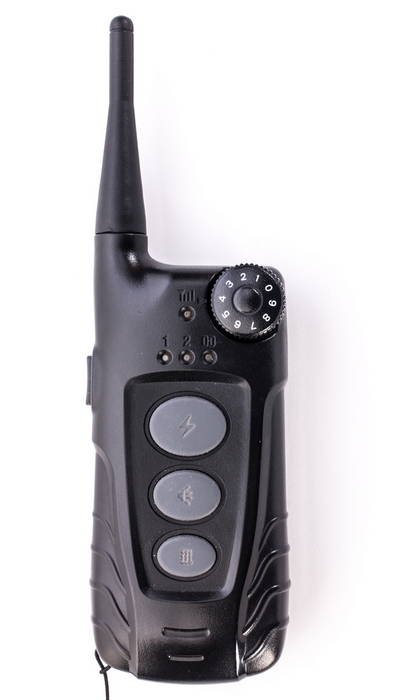An electronic dog collar is a dog training device, also known as dog shock collar, that delivers a small electric shock when the trainer presses a button on a remote control. It is a controversial training method that draws a lot of debates between pet owners and trainers alike. However, it can be an effective way to train dogs when used appropriately and responsibly.
 A dog shock collar is designed to be used as a correctional delivery system, the training concept being similar to giving a short jerk on a leash. The gentle shock should be delivered to distract the dog from whatever undesirable thing he is doing at that moment. Its use should be minimal as part of a carefully planned training regime.
A dog shock collar is designed to be used as a correctional delivery system, the training concept being similar to giving a short jerk on a leash. The gentle shock should be delivered to distract the dog from whatever undesirable thing he is doing at that moment. Its use should be minimal as part of a carefully planned training regime.
I'll avoid going into too many details about the science, controversy, potential health issues and benefits of using dog training collars in this article, since I've already covered a lot of that ground in this article, as well as this one; we also had an interesting interview.
In short, it goes without saying that misuse of a dog shock collar, whether intended or not, will cause your dog pain and can result in further behavioral problems. Dog owners who did not train themselves to use these devices are often unaware that they are misusing a training collar until irreversible damage has been done to the dog.
If you are considering buying a shock collar for your dog, make sure to first research the pros and cons of using the device and learn how to use it responsibly, and as a last resort. Train and educate yourself before you attempt to teach your dog. Consult books, trainers, vets and experts that have knowledge and experience of the science and use of e-collars.
RELATED: No More Pain – Best Alternatives to Dog Shock Collars
15 Vital Safety Tips for Training Dogs with Shock Collars
 1. Get a professional opinion before using a training collar
1. Get a professional opinion before using a training collar
Talk to a dog trainer before you buy a training collar. Talk through your dog’s history, breed tendencies, learning style, health and behaviors. Make sure that you've attempted other dog training methods and choose to resort to a training collar as the last option.
Listen to any advice regarding your pet’s suitability for the e-collar method and take note of alternative training options that may suit him better. In most cases, and with majority of dogs, training them with shock collars isn't necessary and other methods can provide not only safer option, but also be more effective. Discuss this with your vet as well.
2. Buy a tried and tested training collar
 Unfortunately, there are a lot of sub-standard shock collars on the market. Do your research. Ask for recommendations from other dog owners and experts. A poor quality electronic collar can be unreliable or malfunction, and ultimately very dangerous to dogs.
Unfortunately, there are a lot of sub-standard shock collars on the market. Do your research. Ask for recommendations from other dog owners and experts. A poor quality electronic collar can be unreliable or malfunction, and ultimately very dangerous to dogs.
Clearly, the end result could be detrimental to your dog’s physical or mental health. Well regarded manufacturers of dog training collars include Garmin and Dogtra, among many other superior shock collars. There are other popular brands as well, just be sure that you ask for a professional opinion before making your purchase.
3. Choose a dog shock collar with most settings
Bottom of the range collars have as few as 5 settings and top of the range collars can have up to 100 settings. Think about what that means for your dog.
When you increase the setting on a low-end product you’re delivering 20 times more voltage than when you increase the setting on a high end product.
RELATED: How Dog Owners Justify Training Dogs With Shock Collars?
4. Evaluate how your dog responds to it
Be very thorough and precise in paying attention to your dog once you start using this device. How a dog responds to a training tool will depend on a number of factors such as his breed, genetics, temperament and past experiences. Carefully observe your dog’s progress and behavior when you use the e-collar and when you train without it.
What is his body language and rate of learning telling you? Remember that there are alternative training methods that might be better suited to your pet. Some dogs are more sensitive than others, and using shock collars can increase their fear and anxiety.
5. Never use a dog shock collar as a form of punishment
Training collars for dogs don’t deliver a taser gun level of shock, but some of them can still deliver a very powerful jolt to your pet. There are videos on YouTube of people trying them, and not all of those tests turn out well.
Never increase the voltage with the intention of using pain as a punishment. Once again, that is not how a training collar must be used, which is why it's absolutely vital to educate yourself on properly using this device before trying it on your pet.
6. Choose a training collar with an appropriate range
It’s important to buy a collar that fits your purpose. Hunting dogs can range a few miles from their owner. Make sure you’re using an e-collar with a long range, particularly if you’re using the collar to work on recall. You may lose your dog altogether otherwise.
RELATED: How to Use Shock Collars in a Humane Fashion
7. Always use waterproof training collars in wet conditions
Most electronic collars are waterproof but not all. Be absolutely certain that the collar you buy is waterproof before putting it on a damp dog, taking your dog out in inclement weather, or walking near bodies of water.
Some dog training collars can be submerged and are suitable for lake swimming. Be sure to buy one of these if you own a water lover. Again, if you choose a high quality shock collar from a reputable company that invests a lot in their device's safety, then you don't need to worry about any potential issues, since most dog trainers use them as well.
8. Establish your dog’s tolerance
Your e-collar should be set to the lowest possible shock that your dog will respond to. To avoid causing him pain, work from low to high, not high to low.
Here are the steps for finding your dog’s tolerance:
- Place the collar on the dog – it should be loose enough to slip 1 or 2 finger between the collar and your dog’s neck.
- Ensure that the setting is at its lowest possible level.
- Send a quick correction to your pet and observe his response.
- Slowly increase the intensity until your dog shows a small response – flicking ears, scratching neck or looking startled. The intensity should never be raised to give a stronger reaction than this.
9. Teach your dog the language of E-collar training
Take the time to put the different sensations into context for your dog. If he doesn’t know what you expect of him, you can’t expect him to behave as you wish.
If you just put the collar on him and start pushing buttons, he will not understand. He will only be confused and frightened. Allocate each shock sensation to a particular command – beeping tone for ‘sit’, vibration for ‘stay’, etc.
RELATED: Review of Spot Collar for Dogs – No Shock Invisible Fence Solution
10. Understand a dog’s reaction to pain
Pain frightens dogs. They become consumed by the need to escape the source of the pain, by whatever means possible. That usually means resorting to fight, flight or freeze.
Studies have shown that dog shock collars can increase aggression and reduce confidence in dogs for this reason.
Some dogs even struggle to tolerate the sensation of the lowest level shock. If that is the case with your dog then the kindest thing you can do is find an alternative, reward-based training program.
11. Don’t cause your dog to associate you with discomfort
You need your dog to think that his actions are the cause of his discomfort – don’t let him see you using the control. He will quickly learn to fear you, lose respect for you and potentially become aggressive towards you.
As a pet owner, you will get the best from your dog if he sees you as both the disciplinarian and the “safe place”.
12. Never leave a training collar on an unsupervised dog
If a dog shock collar malfunctions or gets damaged it can cause your dog serious electrical burns resulting in long-term physical and psychological damage.
13. Don’t use the collar with a leash
Using a shock collar and a leash at the same time will confuse your dog. Use one form of control or the other. If your dog pulls away from you in response to a shock, then he could snap the lead or injure himself, perhaps fatally.
14. Only shock when absolutely necessary
Training with electronic dog collars is meant to be used sparingly as a supplement to lashings of training rooted in positive reinforcement. Excessive use of shocks will cause your dog stress, and this can often lead to aggression.
15. Time it right
Timing is crucial with an e-collar. The shock needs to be delivered at the very moment the undesirable behavior occurs. If the dog can’t make a connection between his behavior and discomfort, then he doesn’t know what to do to prevent the shock next time.
This can lead to aggression towards the closest person or animal in sight. It also makes for a generally unhappy, insecure and defensive dog. If you have questions about using electronic collars to train a dog, be sure to seek a professional's advice before you begin.
READ NEXT: How No-Pull Dog Harnesses and Collars Help with Dog Leash Pulling















